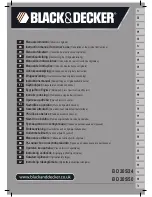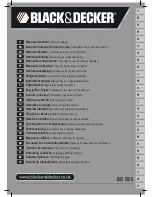
Section 1
SAFETY
1
1.1 GENERAL
Sullair Corporation and its subsidiaries design and
manufacture all of their products so they can be op-
erated safely. However, the responsibility for safe
operation rests with those who use and maintain
these products. The following safety precautions
are offered as a guide which, if conscientiously fol-
lowed, will minimize the possibility of accidents
throughout the useful life of this equipment.
The compressor should be operated only by those
who have been trained and delegated to do so, and
who have read and understood this Operator’s Man-
ual. Failure to follow the instructions, procedures
and safety precautions in this manual can result in
accidents and injuries. Read this manual prior to
startup.
NEVER
start the compressor unless it is safe to do
so.
DO NOT
attempt to operate the compressor with
a known unsafe condition. Tag the compressor and
render it inoperative by disconnecting and locking
out all power at source or otherwise disabling its
prime mover, so others who may not know of the un-
safe condition, cannot attempt to operate it until the
condition is corrected.
Install, use and operate the compressor only in full
compliance with all pertinent regulations and all ap-
plicable Federal, State, and Local codes, standards
and regulations.
DO NOT
modify the compressor and/or controls in
any way except with written factory approval.
While not specifically applicable to all types of com-
pressors with all types of prime movers, most of the
precautionary statements contained herein are ap-
plicable to most compressors and the concepts be-
hind these statements are generally applicable to all
compressors.
1.2 PERSONAL PROTECTIVE EQUIPMENT
Prior to installing or operating the compressor, own-
ers, employers and users should become familiar
with, and comply with, all applicable regulations and
any applicable Federal, State and Local codes,
standards, and regulations relative to personal pro-
tective equipment, such as eye and face protective
equipment, respiratory protective equipment,
equipment intended to protect the extremities, pro-
tective clothing, protective shields and barriers and
electrical protective equipment, as well as noise ex-
posure administrative and/or engineering controls
and/or personal hearing protective equipment.
1.3 PRESSURE RELEASE
A.
Install an appropriate flow--limiting valve between
the service air outlet and the shut--off (throttle)
valve, either at the compressor or at any other point
along the air line, when an air hose exceeding 1/2”
(13mm) inside diameter is to be connected to the
shut--off (throttle) valve, to reduce pressure in case
of hose failure, per all applicable Federal, State and
Local codes, standards and regulations.
B.
When the hose is to be used to supply a manifold,
install an additional appropriate flow--limiting valve
between the manifold and each air hose exceeding
1/2” (13mm) inside diameter that is to be connected
to the manifold to reduce pressure in case of hose
failure.
C.
Provide an appropriate flow--limiting valve at the
beginning of each additional 75 feet (23m) of hose in
runs of air hose exceeding 1/2” (13mm) inside di-
ameter to reduce pressure in case of hose failure.
D.
Flow--limiting valves are listed by pipe size and
rated CFM. Select appropriate valves accordingly,
in accordance with their manufacturer’s recommen-
dations.
E. DO NOT
use air tools that are rated below the
maximum rating of the compressor. Select air tools,
air hoses, pipes, valves, filters, and other fittings ac-
cordingly.
DO NOT
exceed manufacturer’s rated
safe operating pressures for these items.
F.
Secure all hose connections by wire, chain or
other suitable retaining devices to prevent tools or
hose ends from being accidentally disconnected
and expelled.
G.
Open fluid filler cap only when compressor
is not
running and is not pressurized.
Shut down the
compressor and bleed the sump (receiver) to zero
internal pressure before removing the cap.
H.
Vent all internal pressure prior to opening any
line, fitting, hose, valve, drain plug, connection or
other component, such as filters and line oilers, and
before attempting to refill optional air line anti--icer
systems with antifreeze compound.
I.
Keep personnel out of line with and away from the
discharge opening of hoses or tools or other points
of compressed air discharge.
J.
Use air at pressures less than 30 psig (2.1 bar) for
cleaning purposes, and then only with effective chip
guarding and personal protective equipment.
K. DO NOT
engage in horseplay with air hoses as
death or serious injury may result.
L. DO NOT
tamper with sump and unit (if provided)
relief valves. Check the relief valve as recom-
mended in the Maintenance Section of this manual
or at a minimum of at least weekly to make sure it is
not blocked, clogged, obstructed or otherwise dis-
abled.
DO NOT
change the factory setting of the re-
lief valve.
M.
If the compressor is installed in an enclosed
area, it is necessary to vent the relief valve to the
outside of the structure or to an area of non--expo-
sure.
Summary of Contents for ES-11 SERIES
Page 6: ...NOTES...
Page 13: ...Section 2 INSTALLATION 7 Figure 2 1 Service Air Piping...
Page 14: ...8 NOTES...
Page 18: ...Section 4 COMPRESSOR SYSTEMS 12 Figure 4 1A Description of Components...
Page 19: ...Section 4 COMPRESSOR SYSTEMS 13 AIR COOLED WATER COOLED Figure 4 1B Description of Components...
Page 22: ...Section 4 COMPRESSOR SYSTEMS 16 Figure 4 3 Pneumatic Control System Standard Supervisor II...
Page 30: ...24 NOTES...
Page 34: ...28 NOTES...
Page 40: ...Section 7 MAINTENANCE 34 Figure 7 6 Cooler Cleaning COOLER SHROUD COMPRESSOR ENCLOSURE COOLER...
Page 42: ...36 NOTES...
Page 48: ...42 NOTES...
Page 50: ...Section 9 ILLUSTRATIONS AND PARTS LIST 44 9 3 FRAME MOTOR COMPRESSOR AND PARTS...
Page 52: ...Section 9 ILLUSTRATIONS AND PARTS LIST 46 9 4 COMPRESSOR AND PARTS 44...
Page 54: ...Section 9 ILLUSTRATIONS AND PARTS LIST 48 9 4 COMPRESSOR AND PARTS 44...
Page 56: ...Section 9 ILLUSTRATIONS AND PARTS LIST 50 9 5 MOTOR AND PARTS...
Page 60: ...Section 9 ILLUSTRATIONS AND PARTS LIST 54 9 7 COOLING SYSTEM AND PARTS AIR COOLED...
Page 62: ...Section 9 ILLUSTRATIONS AND PARTS LIST 56 9 7 COOLING SYSTEM AND PARTS AIR COOLED...
Page 64: ...Section 9 ILLUSTRATIONS AND PARTS LIST 58 9 8 COOLING SYSTEM AND PARTS WATER COOLED...
Page 66: ...Section 9 ILLUSTRATIONS AND PARTS LIST 60 9 8 COOLING SYSTEM AND PARTS WATER COOLED...
Page 68: ...Section 9 ILLUSTRATIONS AND PARTS LIST 62 9 8 COOLING SYSTEM AND PARTS WATER COOLED...
Page 70: ...Section 9 ILLUSTRATIONS AND PARTS LIST 64 9 9 CONTROL BOX AND PARTS STANDARD NOTE...
Page 72: ...Section 9 ILLUSTRATIONS AND PARTS LIST 66 9 9 CONTROL BOX AND PARTS STANDARD NOTE...
Page 74: ...Section 9 ILLUSTRATIONS AND PARTS LIST 68 9 9 CONTROL BOX AND PARTS STANDARD NOTE...
Page 76: ...Section 9 ILLUSTRATIONS AND PARTS LIST 70 9 9A CONTROL BOX AND PARTS SUPERVISOR II NOTE...
Page 78: ...Section 9 ILLUSTRATIONS AND PARTS LIST 72 9 9A CONTROL BOX AND PARTS SUPERVISOR II NOTE...
Page 80: ...Section 9 ILLUSTRATIONS AND PARTS LIST 74 9 9B CONTROL PANEL AND PARTS ELECTRO MECHANICAL...
Page 82: ...Section 9 ILLUSTRATIONS AND PARTS LIST 76 9 10 CANOPY ACOUSTICAL PANELS AND PARTS...
Page 84: ...Section 9 ILLUSTRATIONS AND PARTS LIST 78 9 10 CANOPY ACOUSTICAL PANELS PARTS...
Page 86: ...Section 9 ILLUSTRATIONS AND PARTS LIST 80 9 11 DECAL GROUP 1 2 3 4 5 6 02250077 472 2A...
Page 88: ...Section 9 ILLUSTRATIONS AND PARTS LIST 82 9 11 DECAL GROUP 8 9 10 11 12 13 7...
Page 91: ...Section 9 ILLUSTRATIONS AND PARTS LIST 85 9 13 WIRING DIAGRAM FULL VOLTAGE SUPERVISOR II...
Page 93: ...Section 9 ILLUSTRATIONS AND PARTS LIST 87 9 15 WIRING DIAGRAM WYE DELTA 50 60 HZ SUPERVISOR II...
Page 97: ...NOTES...








































